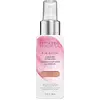What's inside
What's inside
 Key Ingredients
Key Ingredients

 Benefits
Benefits

 Concerns
Concerns

No concerns
 Ingredients Side-by-side
Ingredients Side-by-side

Water
Skin ConditioningButylene Glycol
HumectantPvp
Emulsion StabilisingHydrolyzed Manihot Esculenta Tuber Extract
Skin ConditioningLycium Barbarum Fruit Extract
AstringentRosa Damascena Flower Water
MaskingTerminalia Ferdinandiana Fruit Extract
AntioxidantPPG-3 Benzyl Ether Myristate
EmollientPoloxamer 338
EmulsifyingPolysorbate 20
EmulsifyingPEG-10 Dimethicone
Skin ConditioningPhenoxyethanol
PreservativeCaprylyl Glycol
EmollientEthylhexylglycerin
Skin ConditioningHexylene Glycol
EmulsifyingParfum
MaskingTin Oxide
AbrasiveSodium Hydroxide
BufferingLeuconostoc/Radish Root Ferment Filtrate
AntimicrobialPotassium Sorbate
PreservativeSodium Benzoate
MaskingCitric Acid
BufferingCI 75470
Cosmetic ColorantCI 77491
Cosmetic ColorantMica
Cosmetic ColorantCI 77891
Cosmetic ColorantWater, Butylene Glycol, Pvp, Hydrolyzed Manihot Esculenta Tuber Extract, Lycium Barbarum Fruit Extract, Rosa Damascena Flower Water, Terminalia Ferdinandiana Fruit Extract, PPG-3 Benzyl Ether Myristate, Poloxamer 338, Polysorbate 20, PEG-10 Dimethicone, Phenoxyethanol, Caprylyl Glycol, Ethylhexylglycerin, Hexylene Glycol, Parfum, Tin Oxide, Sodium Hydroxide, Leuconostoc/Radish Root Ferment Filtrate, Potassium Sorbate, Sodium Benzoate, Citric Acid, CI 75470, CI 77491, Mica, CI 77891
Water
Skin ConditioningButylene Glycol
HumectantNiacinamide
SmoothingGlycerin
HumectantPanthenol
Skin ConditioningPentylene Glycol
Skin ConditioningCeramide AP
Skin Conditioning1,2-Hexanediol
Skin ConditioningCaprylyl Glycol
EmollientCarbomer
Emulsion StabilisingAllantoin
Skin ConditioningAloe Barbadensis Leaf Juice
Skin ConditioningDipotassium Glycyrrhizate
HumectantDisodium EDTA
Hydrolyzed Hyaluronic Acid
HumectantPolysorbate 20
EmulsifyingSodium Hydroxide
BufferingCollagen Amino Acids
MoisturisingTitanium Dioxide
Cosmetic ColorantLeuconostoc/Radish Root Ferment Filtrate
AntimicrobialAgar
MaskingCalcium Alginate
MaskingXanthan Gum
EmulsifyingPhenoxyethanol
PreservativeHydroxyacetophenone
AntioxidantSodium Hyaluronate
HumectantTocopheryl Acetate
AntioxidantTropolone
Skin ConditioningChromium Hydroxide Green
Water, Butylene Glycol, Niacinamide, Glycerin, Panthenol, Pentylene Glycol, Ceramide AP, 1,2-Hexanediol, Caprylyl Glycol, Carbomer, Allantoin, Aloe Barbadensis Leaf Juice, Dipotassium Glycyrrhizate, Disodium EDTA, Hydrolyzed Hyaluronic Acid, Polysorbate 20, Sodium Hydroxide, Collagen Amino Acids, Titanium Dioxide, Leuconostoc/Radish Root Ferment Filtrate, Agar, Calcium Alginate, Xanthan Gum, Phenoxyethanol, Hydroxyacetophenone, Sodium Hyaluronate, Tocopheryl Acetate, Tropolone, Chromium Hydroxide Green
Ingredients Explained
These ingredients are found in both products.
Ingredients higher up in an ingredient list are typically present in a larger amount.
Butylene Glycol (or BG) is used within cosmetic products for a few different reasons:
Overall, Butylene Glycol is a safe and well-rounded ingredient that works well with other ingredients.
Though this ingredient works well with most skin types, some people with sensitive skin may experience a reaction such as allergic rashes, closed comedones, or itchiness.
Learn more about Butylene GlycolCaprylyl Glycol is a humectant and emollient, meaning it attracts and preserves moisture.
It is a common ingredient in many products, especially those designed to hydrate skin. The primary benefits are retaining moisture, skin softening, and promoting a healthy skin barrier.
Though Caprylyl Glycol is an alcohol derived from fatty acids, it is not the kind that can dry out skin.
This ingredient is also used as a preservative to extend the life of products. It has slight antimicrobial properties.
Learn more about Caprylyl GlycolLeuconostoc/Radish Root Ferment Filtrate is a natural preservative. It comes from fermenting radish roots with a bacteria called leuconostoc.
Leuconostoc comes from lactic acid.
This ingredient has antimicrobial properties and helps prevent the growth of bacteria in a product.
Leuconostoc is used to make the traditional Korean side-dish, kimchi. It is also used to make sourdough bread (both incredibly yummy foods).
Learn more about Leuconostoc/Radish Root Ferment FiltratePhenoxyethanol is a preservative that has germicide, antimicrobial, and aromatic properties. Studies show that phenoxyethanol can prevent microbial growth. By itself, it has a scent that is similar to that of a rose.
It's often used in formulations along with Caprylyl Glycol to preserve the shelf life of products.
Polysorbate 20 is made by combining ethoxylation of sorbitan, ethylene oxide, and lauric acid. It is a mild cleansing agent, surfactant, and emulsifier.
As a surfactant, it helps collect dirt and oils for washing. Emulsifiers prevent oils and water from separating.
Polysorbate 20 also adds scent to a product. Since it is made using sorbitol, it has a sweet scent. Sorbitol can also be found in fruits such as apples and peaches.
The lauric acid used to create Polysorbate 20 is often derived from coconuts.
Polysorbate 20 may not be fungal acne safe.
Learn more about Polysorbate 20Sodium Hydroxide is also known as lye or caustic soda. It is used to adjust the pH of products; many ingredients require a specific pH to be effective.
In small amounts, sodium hydroxide is considered safe to use. However, large amounts may cause chemical burns due to its high alkaline.
Your skin has a natural pH and acid mantle. This acid mantle helps prevent harmful bacteria from breaking through. The acid mantle also helps keep your skin hydrated.
"Alkaline" refers to a high pH level. A low pH level would be considered acidic.
Learn more about Sodium HydroxideWater. It's the most common cosmetic ingredient of all. You'll usually see it at the top of ingredient lists, meaning that it makes up the largest part of the product.
So why is it so popular? Water most often acts as a solvent - this means that it helps dissolve other ingredients into the formulation.
You'll also recognize water as that liquid we all need to stay alive. If you see this, drink a glass of water. Stay hydrated!
Learn more about Water